The World War II bomber at the bottom of Lake Mead

Editor's note: This piece is republished with the permission of H2O Radio, which like The Nevada Independent is a member of the Institute for Nonprofit News.
In 1948, a World War II-era bomber crashed into Lake Mead, the massive reservoir formed by Hoover Dam that straddles the Arizona-Nevada border. After several failed attempts to locate the plane, it was finally discovered in the early 2000s—still remarkably intact. As lake levels fall, will the draw to see the aircraft finish it off?
Lake Mead, Nevada — The official crash report said the pilots were flying low to collect a last bit of scientific data before returning to base and that the instruments on their B-29 aircraft were improperly calibrated. Also, the account said that Lake Mead—smooth as glass on that July morning in 1948—distorted their depth perception and sent the plane skipping like a stone across the water.
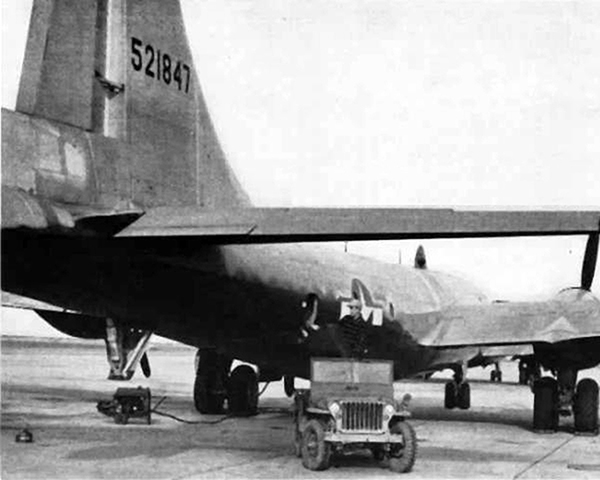
There’s another side of the story that's not in the official record but was part of the lore repeated by the flight crew and the scientist afterward, says Susan Edwards, an archaeologist and historian at the Desert Research Institute or DRI. "The pilots were hotdogging. It's fun to fly as low as you can. It just is.”
Whatever the truth, when the B-29 (S/N 45–21847) hit Lake Mead, the impact stripped off three of its four engines and took out part of the tail as one of them whipped past. Edwards says the pilot, Captain Robert M. Madison, and the co-pilot, 1st Lieutenant Paul M. Hesler, were able to wrestle the plane back into the air for about another 200-300 yards, but with only one engine left and it on fire, the pilots feathered it and were able to ditch the plane straight and level.
They popped the hatches to escape—four of the five crew members, anyway. Sergeant Frank Rico was in the back of the plane and broke his arm after being thrown against the bulkhead. He was trying to crawl from the rear cabin to the nose of the plane, but his parachute got stuck.
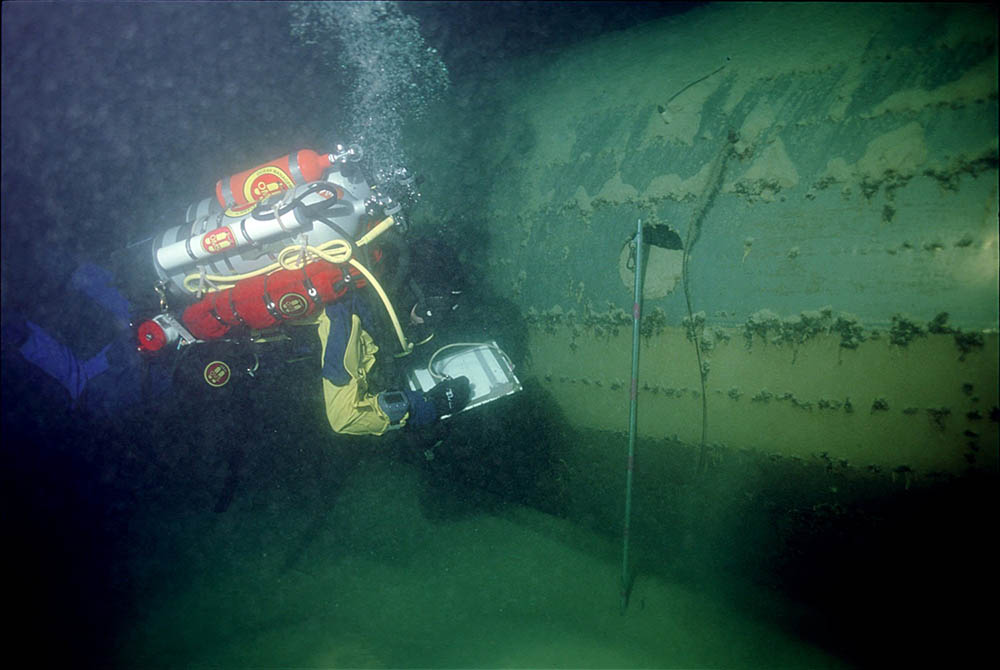
The B-29 was going down tail first. The crew realized that Rico had not surfaced and heard him banging on the interior. Madison, and the scientist aboard that day, John W. Simeroth, went back in and were able to drag Rico through the aircraft and then out emergency windows on the cockpit. They all got into rafts, and the plane went down about 12 minutes later.
The crew hadn’t been required to file a flight plan, so no one from the InyoKern military base in the California desert (now called China Lake) where the flight originated was aware of the accident. The airmen discharged a dye canister, and a TWA pilot, who served in World War II and was flying overhead, recognized the distress signal and reported it.
The men were rescued five hours later by Park Service personnel, but the B-29 would come to rest in a watery catacomb almost 280 feet below the lake’s surface.
The Birth of the B-29 Superfortress
What was the B-29 doing flying over Lake Mead that day? Jeff Wedding, an archeologist and Sue’s colleague at DRI, explains its story starts with the rise of the Nazi Party in Germany and the September 1939 invasion of Poland.
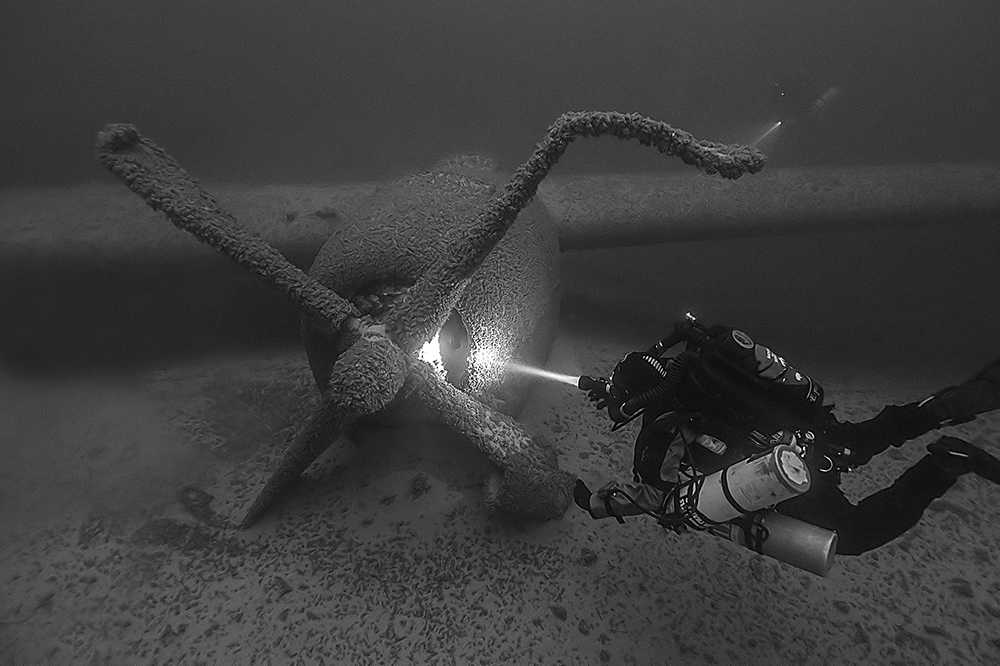
The military was recognizing that the U.S. might be drawn into a global conflict in Europe and perhaps the South Pacific. Wedding says, in early 1940 a call went out from the War Department to develop a new bomber—something that could carry a heavier load and fly greater distances. The president of Boeing responded, and the company started putting designs on the drawing board for the “B-29 Superfortress.”
After the attack on Pearl Harbor on December 7, 1941, Boeing moved ahead with its development of the B-29—a plane that would push the boundaries of aviation design. Wedding says it would be twice the size of existing bombers, carry double the payload, go twice the distance, and travel 100 miles an hour faster than anything flying at the time. It would also be the first military aircraft to have a pressurized cabin. Crews flying combat missions aboard B-17 and B-24 aircraft wore heavy winter gear and used oxygen at altitude. In the B-29, pilots could fly in shirtsleeves, breathing cabin air like a passenger would on an airliner today.
A squadron of B-29s, referred to as "Silverplate" bombers, were specifically designed to carry the atomic bomb. In August 1945, the Enola Gay carrying “Little Boy” struck Hiroshima, and the Bockscar, carrying “Fat Man” hit Nagasaki, effectively ending the war.
The Lake Mead B-29 rolled off the assembly line 11 days after the Japanese surrender in September 1945, so it never saw combat. It was designed for photo reconnaissance, and to reduce weight and provide space for the cameras, it carried no military hardware. It was intended to accompany a combat mission or fly after one to take damage assessment photographs or take preliminary photos of a target to identify the military infrastructure.
The Sun Tracker
After the war, many B-29s were mothballed, but the Lake Mead plane with its observation windows was perfectly suited to do research that had been put on hold during the war years—in particular, research on cosmic rays. Cosmic rays are high-energy particles that originate in deep space and are constantly bombarding the earth. The vast majority don't make it past Earth’s upper atmosphere without splintering into secondary rays.
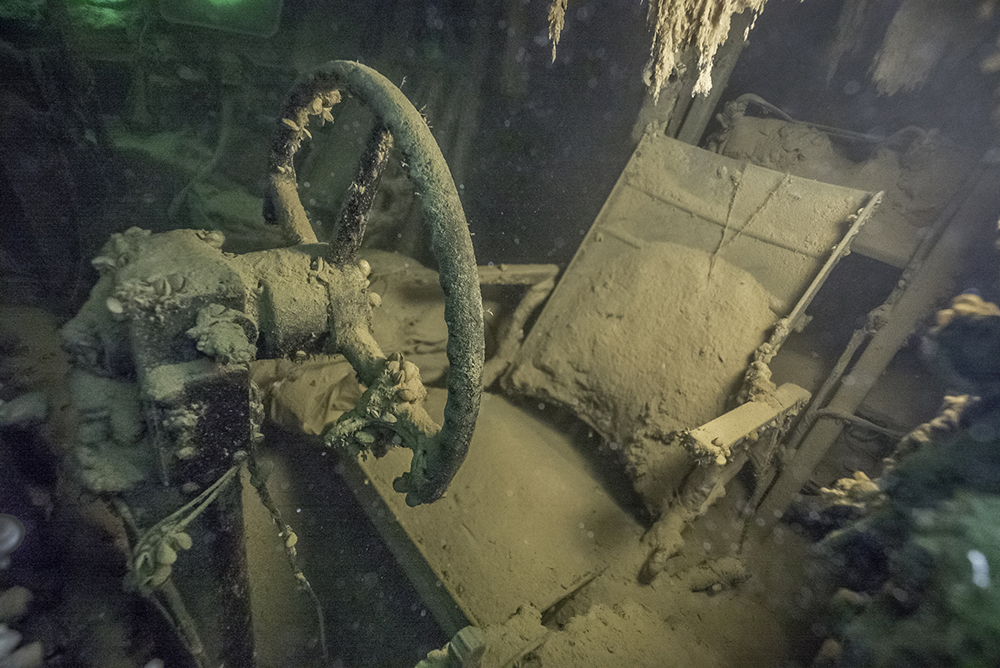
Dr. Carl Anderson, a professor of physics at the California Institute of Technology (CalTech) and Nobel Laureate, saw the potential of using B-29s to study cosmic rays. Because the planes could fly at altitudes in excess of 30,000 feet and could carry a heavy payload—in this case, not bombs but his 5,000-pound cloud chamber that detected cosmic rays—he figured he could acquire better data.
He ran a request up the chain in the military to use a B-29, and eventually three planes were assigned to Project APOLLO, the High Altitude Flying Laboratory Program, and were based at Naval Ordnance Test Station (NOTS) InyoKern, now called Naval Air Weapons Station (NAWS) China Lake. The majority of the flights studied cosmic rays, but some experiments were about terrestrial radiation, geomagnetic fields, and solar spectroscopy.
Aboard the Lake Mead B-29 on July 21, 1948 was an instrument called the Sun Tracker. Project 288, as it was known, was charged with measuring the intensity of light at different altitudes, including infrared light. The mission required that the crew fly at certain altitudes and at certain rates of climb and descent, with John Simeroth taking measurements along the way.
Edwards and Wedding, who are writing a book about the B-29, say there is a persistent misconception that the aircraft was on a secret mission, which started with the first news reports of the crash in 1948 and continues to this day. Simeroth's assignment was on an "unclassified" basis. Edwards writes in a paper for the Preserving U.S. Military Heritage, World War II to the Cold War conference that “while specifics on the equipment might have been proprietary and the military's intended use of the data was classified, the research itself apparently was not.” She goes on to say that the “Sun Tracker most likely contained an early version of components adapted for use in 'heat-seeking' guided missiles like the Sidewinder, a weapon first tested in 1951 and still in use today."
Lost... and Found
There were a few unsuccessful efforts to locate the plane, including by the co-pilot Hesler, who had hired a salvage diver. Also, park staff at the time went to the Overton Arm area of Lake Mead where the plane went down to look for fuel stains on the water’s surface.
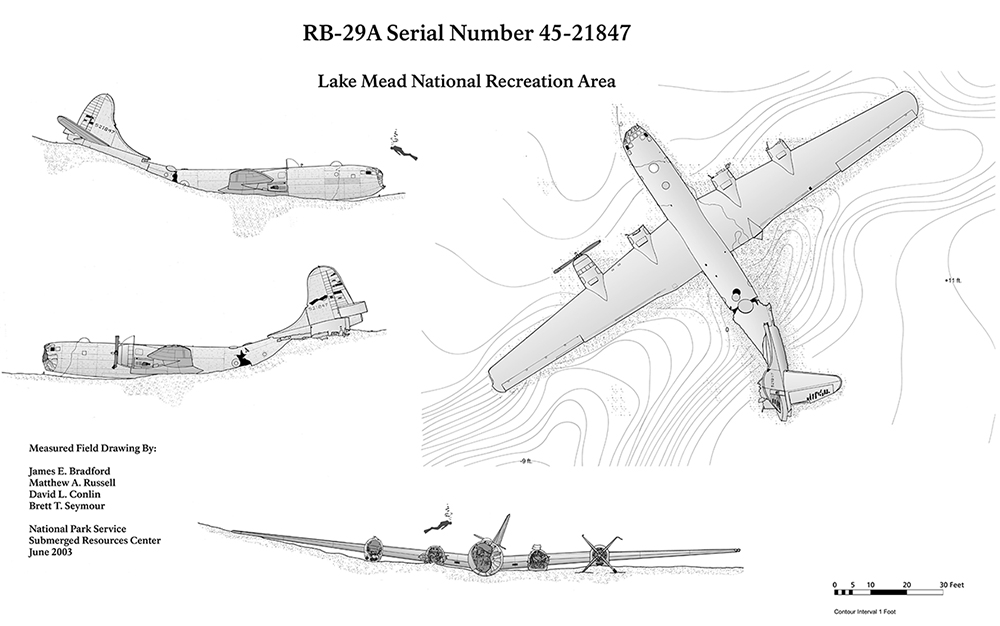
It sat undisturbed until 2001, when a local diver, using a side-scan sonar—which without a permit is against park regulations and illegal—located the B-29.
Dave Conlin, chief of the Submerged Resources Center (SRC) of the National Park Service, which manages underwater assets in the park system, recounts that the man and his team started diving on the plane at a depth of 230 feet. Over the course of a year, Conlin says, they set up lights and were filming, and also removed items from the B-29. Their idea was to do a documentary, file a salvage claim under admiralty law, raise the aircraft from the bottom of the lake, and sell it.
Lake Mead National Recreation Area officials only found out about the discovery after one diver’s father held a press conference to announce that the aircraft had been found. They refused to release the coordinates to park staff, so Conlin’s team asked the Bureau of Reclamation for help. The agency conducts surveys to assess how sedimentation is changing the water volume of the lake, and using their high-resolution data, the SRC was able to locate the plane.
In 2003, Conlin’s team made their first dive to map and document the site, which he describes as “one of the most memorable of my career” for being “so scary, so deep, and so dark.” That is, he said, until “suddenly we saw the aircraft and it was just...beautiful. It sat there like a silver spaceship. It was clean and shiny, and you could see all the stenciling.” He could also see the damage that was done by the surreptitious divers, but overall, he says, it was a stunning and remarkable sight.

At the same time the SRC team was assessing the plane’s condition, a court battle was proceeding over ownership of the B-29 in which the Park Service prevailed as the rightful custodian on behalf of the American people. Today the challenge is how to have the public appreciate the B-29 and its history.
To B or Not to B
Although the scientific data were lost in the wreck, the fuselage of the Lake Mead B-29 is remarkably intact—even with the co-pilot’s headset still dangling on the stick, along with Frank Rico’s parachute after they cut him free.
Matthew Hanks, an archeologist with SRC says he has dived on a handful of WWII aircraft around the world and the wrecks weren’t remotely recognizable as planes—most having been shot down with a very destructive landing. “So, the B-29 in Lake Mead is unique in that the wrecking event, as far as a plane crashes go, was pretty gentle.”
Also, he says the plane is sitting in cold, deep freshwater that's an optimal environment for its preservation and wouldn’t deteriorate as fast as had the aircraft been in corrosive ocean saltwater.
While that sounds like good prospects for preserving the B-29, it’s facing modern threats. First, starting in 2007, quagga mussels—a tiny invasive species from Ukraine that harms ecosystems and damages infrastructure, started appearing in the lake. The plane is now covered with the pistachio-sized creatures that have embedded themselves in the aluminum and are weighing on the fabric and the structural members.
Hanks says that by the time he dived down to the B-29 in 2015, there was “absolutely no visible aluminum—no shine, none of that sort of picturesque imagery that I had seen in the past.” It was still impressive, he says, but just different. Also, sediment collecting in the lake has found its way into the nooks and crannies among the mussels, adding to the weight resting on the plane.
Second, lake levels are falling because of reduced precipitation in the West, and now the B-29’s depth fluctuates between being 90 and 105 feet below the surface—easily within the range of recreational divers. Also, climate change is bringing higher temperatures and the plane is sitting in increasingly warmer water.
Still, the B-29 is a remarkable historic asset, if not perhaps a bit more fragile for having been discovered by divers and then invasive mussels. So, the dilemma for the Park Service is how to strike a balance between allowing people to experience their history and their heritage—and locking the plane away for its own good.
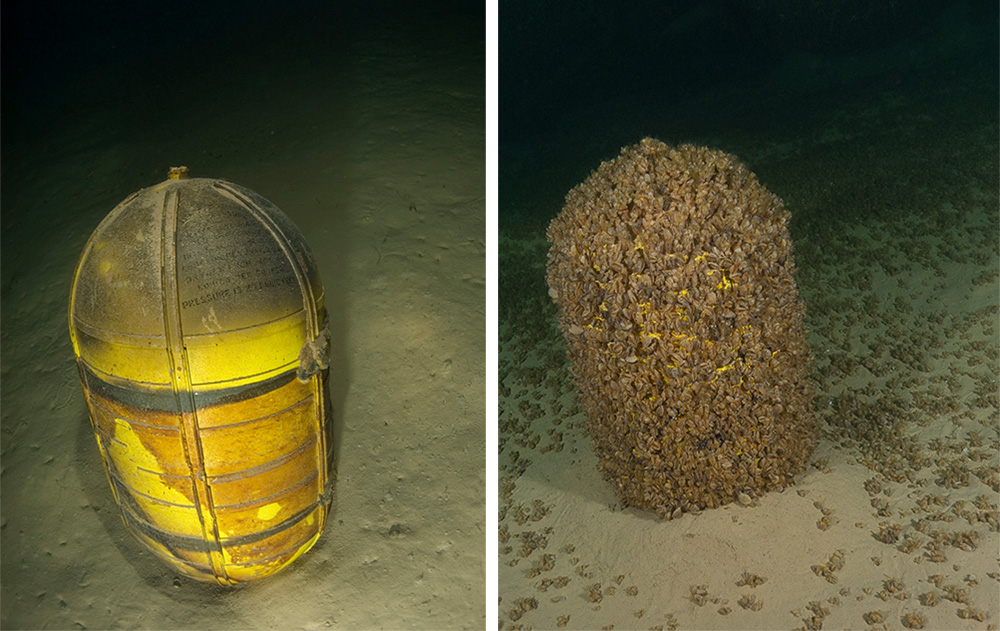
Currently, officials with the Lake Mead National Recreation Area have allowed two concessionaires to lead guided dives on the plane. The SRC will assess the cumulative impact of the divers on the aircraft and try to separate out natural deterioration. Conlin believes the aircraft can both be protected for future generations and offer a recreational opportunity—in part because the divers themselves are passionate about the B-29 and want to see it preserved.
Another way to protect the plane is to raise the public’s awareness of its story. The B-29 is currently listed on the National Register of Historic Places, and the Park Service is pursuing designating it as a National Historic Landmark—a much higher status and an indication on the part of the American people that these particular places or objects are important. The B-29 application is currently under review, and a decision is expected perhaps as early as summer 2021.
In the meantime, Conlin says, it's still an incredible resource and an incredible story. The Park Service, he says, is in the “the forever business” and has a mandate to involve the American people in their national parks—to show them exceptional resources, exceptional areas of natural beauty, and places where incredible historic events happened. “In the process of doing that, we don't want the thing that we're showing people to be destroyed.”
Conlin reflected, “Do I wish that it still looked like a spaceship? Absolutely. My job is to leave our parks the way I found them. And if I do my job well, no one will ever know that I ever did my job.”
